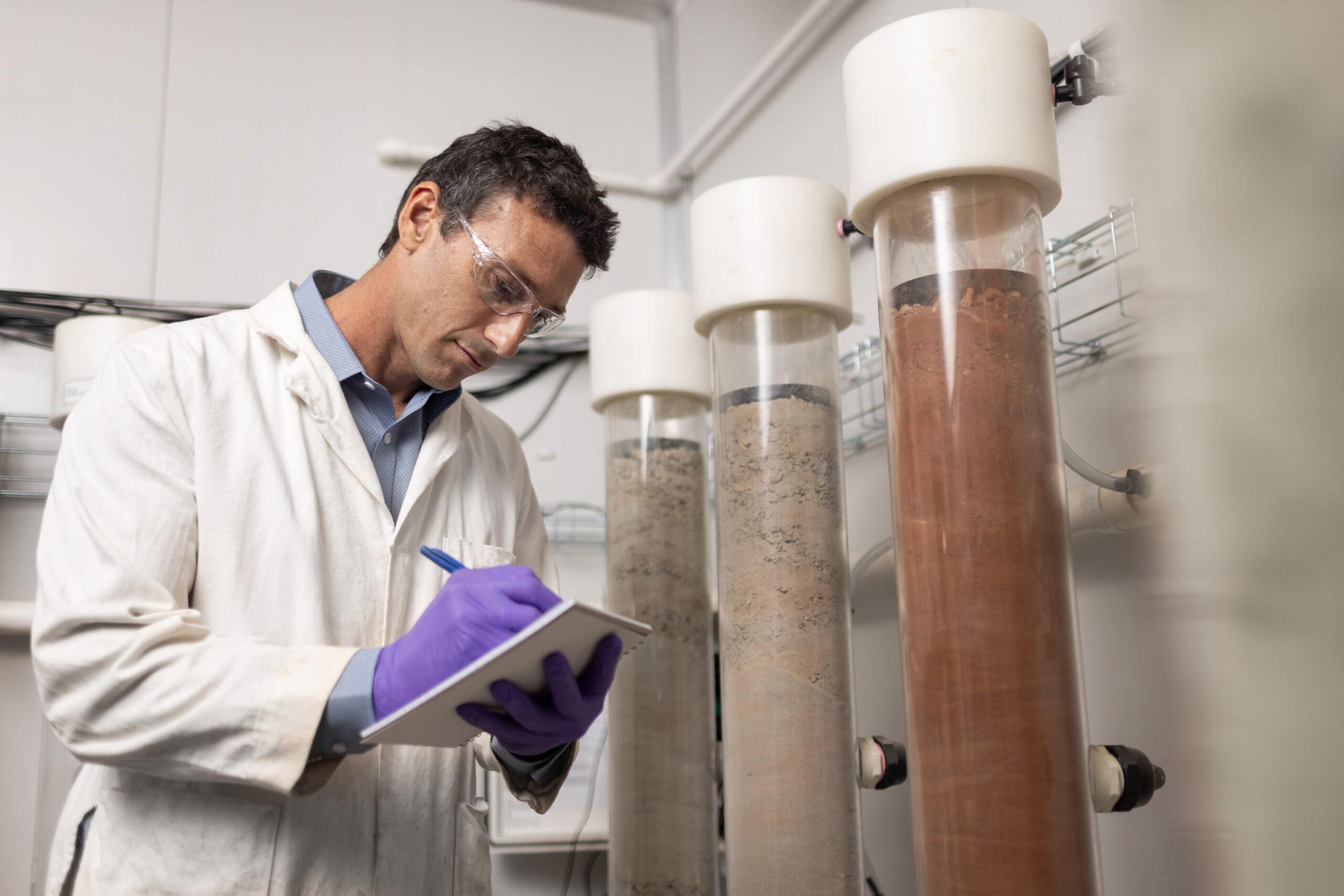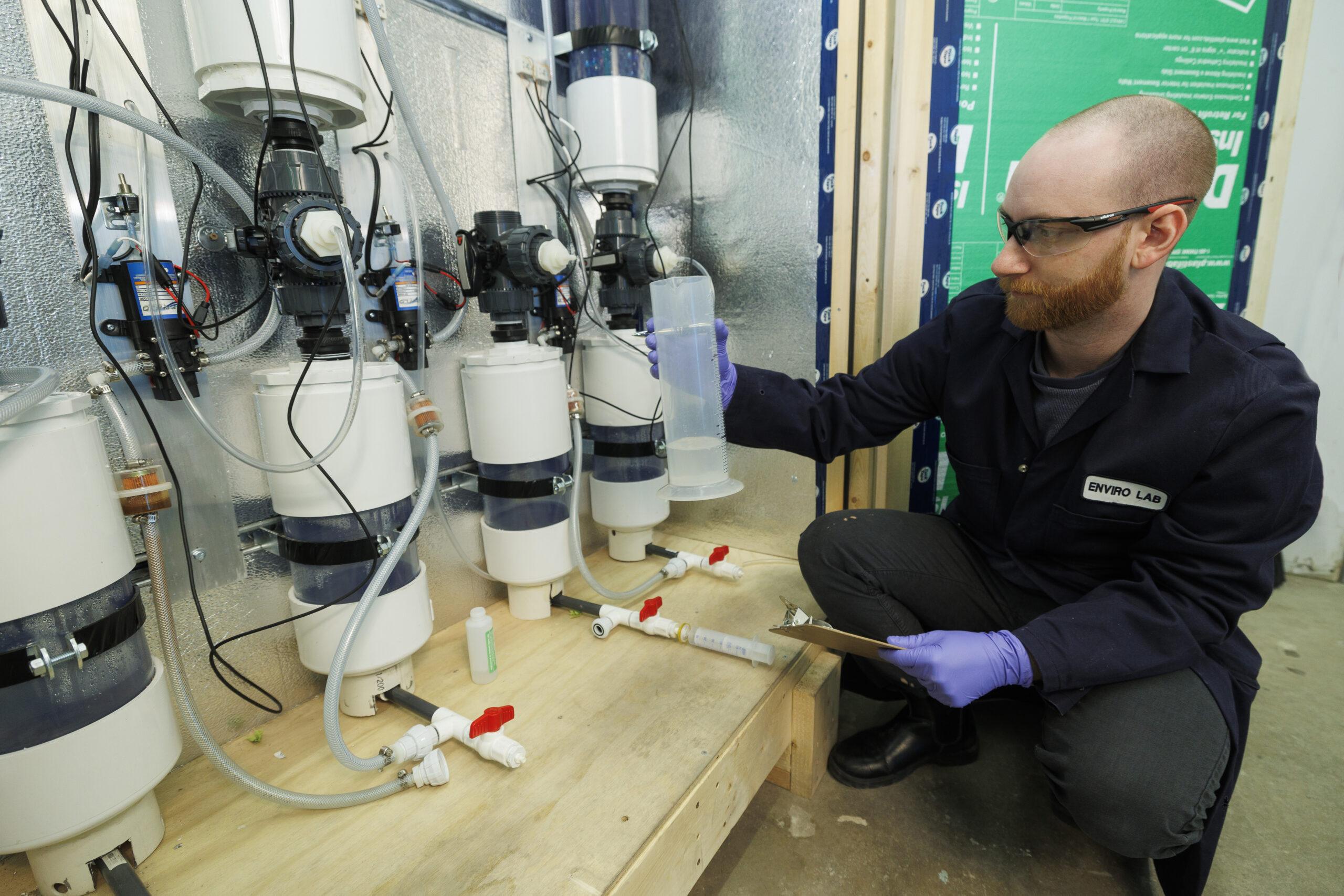- January 20, 2025

Enhancing Kinetic Testing to Better Address Acid and Metalliferous Drainage
Effectively addressing acid and metalliferous drainage (AMD), or metal leaching and acid rock drainage (ML/ARD), requires a foundation of expertise and tools to manage the complex interactions between mine materials and the environment. Geochemical tests, such as static and kinetic tests, are common methods in profiling and predicting AMD, providing site owners and key decision makers with insights and knowledge for AMD mitigation and management.
This month’s Conversation on Closure explores kinetic testing, the valuable insights it provides for predicting AMD, and the key factors to consider in evolving testing conditions to better inform and improve AMD management strategies.
What is Kinetic Testing?
Kinetic testing is a laboratory method used to assess and predict the rate and potential for AMD from mine rocks and tailings (Downing, 2014). The process involves exposing samples from potentially reactive mine materials to weathering cycles in order to measure the rates of AMD production.
Kinetic tests offer insights into the long-term generation of AMD (MEND, 1995), providing critical data for designing effective mitigation measures to manage and prevent AMD during mine operations and throughout the mine closure process.
Standard Kinetic Testing Methods for Addressing AMD
The two most common types of kinetic geochemical tests used to predict AMD generation are column leach tests (across a range of configurations) and humidity cell tests. These tests use a few kilograms of material that has been crushed to a few millimetres in size and then exposed to wetting and drying cycles with very high leaching rates (i.e., high liquid to solid ratios). The processes, benefits, and limitations of each test are summarized in Table 1 below.
| Kinetic Tests | Process | Benefits | Limitations |
| Column Leach | Column leach tests measure the leaching rate of metals and other ions relevant to AMD from leachate collected from periodically wetted test materials in columns (Davis et al., 2014). | Operating parameters of column tests are not standardized and can be customized to simulate natural weathering processes that are expected to occur at a mine site. If the correct parameters are selected for the test work, a more accurate measure of drainage chemistry at the field scale can be measured (INAP, 2012). | Column tests can be time-consuming, costly, and prone to challenges like material channelling along column walls and clogging, risking inaccurate and inefficient analysis (Wang, 2016). |
| Humidity Cell | Humidity cell testing is a standardized protocol that aims to accelerate mineral weathering reactions by applying elevated wetting rates, temperature, and humidity (Davis et al., 2014). | Humidity cell tests are standardized methods that yield quicker results and enable consistent test conditions to predict whether a material will produce acidic, alkaline, or neutral water when exposed to air and moisture (Punkkinen et al., 2019). | Humidity cell tests do not fully replicate real, on-site conditions, as water flow rates and temperatures are often overestimated, leading to different geochemical conditions that create drainage that is less representative of the site (Punkkinen et al., 2019). |
Table 1. Summary of standard kinetic tests.
In the prediction of drainage chemistry, an important aspect is reasonably upscaling the results of small-scale test work to larger scales (Morin, 2013). Scaling factors that require consideration when using kinetic test data for predictions of field conditions include particle size, mass of material, oxygen supply, temperature, and liquid to solid ratio.
It is Okane’s experience that small-scale standard kinetic test methods generally do not represent field conditions, resulting in the need to rely on significant hydrological and geochemical scaling factors. A major reason for the errors in AMD prediction is the scaling factors for small-scale kinetic test work.
Humidity cell tests generally do not sufficiently replicate the geochemical, hydrological, and physical conditions found in mining landforms such as mine rock stockpiles or tailings storage facilities. For example, when conducting kinetic tests on porphyry copper tailings, standard humidity cell testing procedures did not provide an accurate prediction of the behaviour of flotation tailings (Dold, 2014). Moreover, achieving acidic pH conditions due to oxidation at rates similar to field conditions can take years, making the duration of a laboratory humidity cell test program for tailings often too short to simulate long-term processes accurately.
Column leach tests, on the other hand, are non-standardized and have the flexibility to be designed to better replicate site-specific conditions, which is integral for addressing unique AMD challenges. However, if columns are not designed to integrate site-specific conditions, small-scale laboratory column tests may not be reliable for field applications.
Okane’s Approach to Enhance Column Leach Testing
To more accurately translate the findings of laboratory studies to field scale, Okane has developed advanced customizable leach columns (ACLCs), a testing method that considers the site-specific conditions of a site to better replicate drainage that would occur at the field scale. The key features of ACLCs that can decrease uncertainty in AMD assessment include:
- ACLCs being placed in climate-controlled units to best replicate the site-specific temperatures.
- Adjustable gas composition and flow rate to measure oxidation rates under different O2
- O2 and CO2 sensors to estimate sulfide intrinsic oxidation rate, sulfide and carbonate reactivity, and organic carbon oxidation rate.
- Volumetric water content and matric potential sensors to monitor and assess water and temperature conditions inside the column.
- Leachate collection system to track and measure leachate quality over time.

Figure 1. Okane’s ACLCs in our Saskatoon laboratory.
By applying site-specific conditions to the ACLCs, we gain insights into the potential long-term AMD processes associated with a site’s mine rock or tailings, with a decreased dependence on the numerous required by other kinetic tests (Freidman, 2024).
A key example of considering site-specific conditions is the application of Okane’s ACLCs to semi-arid environments like the Pilbara in Western Australia, where mine rock storage facilities can have liquid to solid ratios as low as 0.001:1 (Pearce and Pearce, 2016). Alternatively, standard methods (like free-draining leach columns) have high annual liquid to solid ratios of approximately 8:1, for example. The difference between field and laboratory liquid to solid ratios is therefore many orders of magnitude.
Our interdisciplinary team of geoscientists can leverage data collected from the ACLCs to deliver customized and in-depth data interpretations to assist mine owners to (Freidman, 2024):
- develop source terms to inform water balance/water quality models;
- understand gas transport and oxygen consumption rates;
- inform operations and construction guidance of mine materials, such as maximum lift exposure time and optimum lift thickness; and,
- inform closure plans, such as progressive rehabilitation and cover systems.
Okane’s ACLCs are housed in semi-automated laboratories in both Canada and Australia, where gas flux rates, ambient temperatures, water application, drying, and particle sizing can be closely controlled and monitored.
To learn more about how Okane can help conduct kinetic test work for your site, please reach out to info@okaneconsultants.com.
References
Davis, B., Bourgeot, N., & Taylor, J. (2014). Using kinetic geochemical testwork to assist with mine planning, operations and post closure. In H. Miller & L. Preuss (Eds.), Proceedings of the Eighth Australian Workshop on Acid and Metalliferous Drainage 2014 (pp. 281-294).
Dold, B. (2014). Evolution of Acid Mine Drainage Formation in Sulphidic Mine Tailings. Minerals 4, 621-641.
Downing, B. (2014). Kinetic testing procedures. In J.A. Jacobs, J.H. Lehr, & S.M. Testa (Eds.), Acid mine drainage, rock drainage, and acid sulfate soils: Causes, assessment, prediction, prevention, and remediation. Wiley Online Library. https://doi.org/10.1002/9781118749197.ch21
Freidman, B. (2024, May 29). Leveraging the benefits of kinetic leach column design for your project: Balancing regulatory guidance, material type, and site-specific conditions [Webinar presentation]. The Closure Planning Practitioners Association, Western Australia.
The International Network for Acid Prevention (INAP). 2012. Global Acid Rock Drainage Guide (GARD Guide). http://www.gardguide.com/
Morin, K.A. (2013). Scaling Factors of Humidity-Cell Kinetic Rates for Larger-Scale Predictions. www.mdag.com/case_studies/cs38.html.
Mine Environment Neutral Drainage (MEND). (1995). Evaluation of static and kinetic prediction test data and comparison with field monitoring data (MEND Project 1.16.4). MEND. https://mend-nedem.org/wp-content/uploads/1164.pdf
Pearce, S., Pearce, J. (2016). Advanced Customisable Leach Columns (ACLC) – A New Kinetic Testing Method to Predict AMD risks by Simulating Site-specific Conditions. Proceedings IMWA, Freiberg, Germany.
Punkkinen, H., Juvankoski, M., Kaartinen, T., Laine-Ylijoki, J., Merta, E., Mroueh, U., Mäkinen, J., Niemeläinen, E., & Wahlström, M. (2019). Humidity cell testing. Mine Closure web pages, Closedure, Geological Survey of Finland.
Wang, G. C. (2016). Environmental aspects of slag utilization. In, The utilization of slag in civil infrastructure construction. Elsevier Ltd. https://doi.org/10.1016/C2014-0-03995-0
